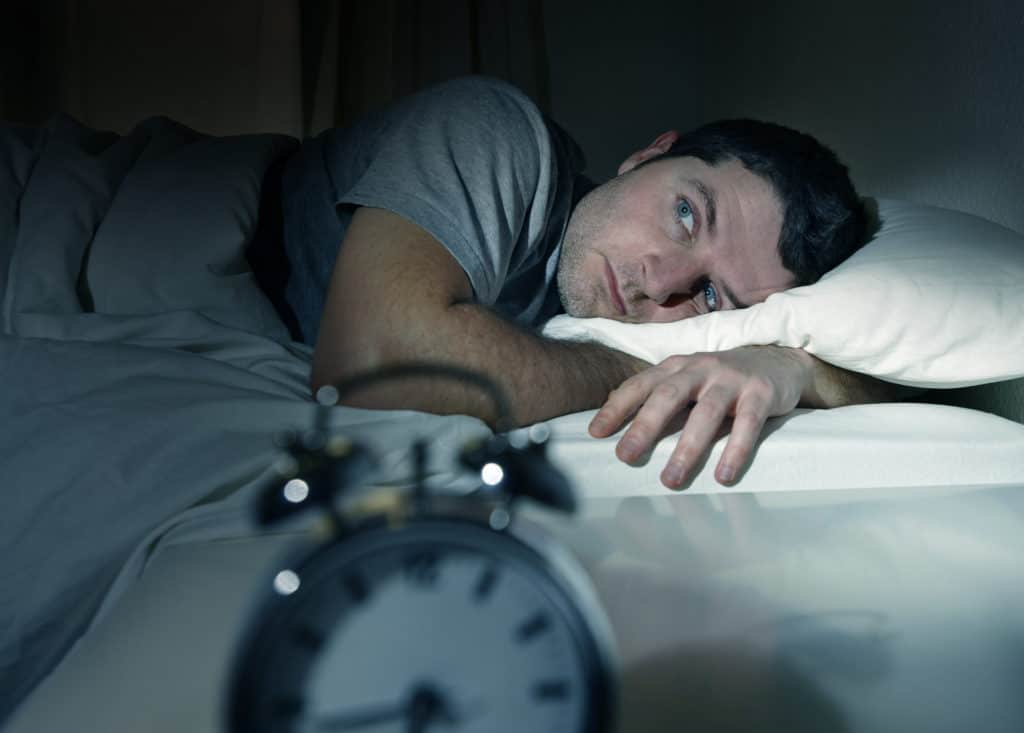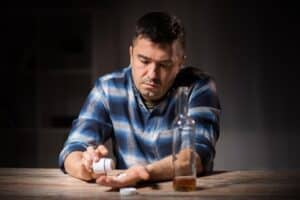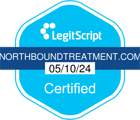There are various ways that heroin addiction can change your physical appearance and affect your mental health. Although it doesn’t occur right away, there are symptoms of heroin addiction that can lead in that direction. An obvious sign of heroin addiction is drug paraphernalia, since heroin is ingested by smoking, snorting, and injection.
Heroin is most regularly distributed as an off-white powder cut with additives like sugar or powdered milk. When injected, it’s dark brown or black in color and resembles a tar-like quality, due to the processing methods, and injected into the veins or muscles. Lighters and pipes, needles and arm bands, and/or razor blades and mirrors are all typical paraphernalia indicative of heroin use in its various forms. Bruises or scabs on the skin where heroin was injected are also signs of recurring use.
Another sign is the presence of multiple pain medication bottles. Prescription opioids often lead to heroin addiction and have become a rising epidemic over the past few decades. Prescription medication like Vicodin and Oxycontin have similar effects to heroin and are equally highly addictive. Taking opioids in excess of a doctor’s prescription or misused in any way can lead to addiction.
This physical evidence of heroin abuse in combination with changes in appearance and behavior are significant ways to tell if someone is forming an opioid addiction. Initially, when a person uses heroin, the immediate effects are relaxed or euphoric. However, the half-life lasts mere minutes before the drug starts to lose its effect. The aftermath of the high is an extreme low, where the person may seem to nod off between consciousness and subconsciousness or become disoriented.
There are other substance abuse physical symptoms that occur. These include constricted pupils, dry mouth, shortness of breath, and extreme itchiness. Heroin abuse and addiction may result in drastic weight loss, decreased attention to appearance and hygiene, and an increased sense of agitation and paranoia. Additional long-term signs and symptoms may develop depending on the time span and severity of the addiction, such as:
- Insomnia
- Liver and kidney disease
- Lung complications
- Infection of the heart lining and valves
- Collapsed veins (for those injecting heroin)
- Damaged nasal tissue (for those who snort the drug)
- Depression
The variety of heroin abuse symptoms and the severity of each is determined by your level of addiction. How long have you battled it? How frequently do you use heroin currently? Each person’s experience involves risk factors that affect their actions and reactions to addiction.
Withdrawal Symptoms of Heroin Addiction
In addition to the physical signs of heroin addiction, the body reacts intensely when abstaining from the drug when addicted. Withdrawal symptoms occur within a few hours after the last dosage. Due to their painful intensity, they usually cause a person to relapse and continue using to temporarily combat the pain and severity of these occurrences.
Heroin addiction withdrawal symptoms usually peak in intensity within the first few days before slowly tapering off after approximately one week. This process of detoxification rids the body of the drug and all toxins as the first step of an addiction treatment program. Heroin addiction withdrawal symptoms include:
- Severe muscle and bone pain
- Diarrhea
- Nausea and vomiting
- Restlessness and insomnia
- Cold flashes and goosebumps
Serious cravings still occur, all of which makes it difficult for a person to go through detox alone. Plus, the unpredictability of the body’s reaction to the cycle of addiction and withdrawal can be unsafe. It’s best to receive treatment through a medically managed program where your health can be monitored around-the-clock. Addiction impacts the brain’s ability to function properly and changes the way you think and act, which can lead to other reckless and dangerous behavior.
How Does Addiction Happen?
Heroin enters the brain right away and attaches to the opioid receptors, which leads to feelings of pleasure and easing of pain. This rush causes people to want to take larger doses at greater frequencies. Long-term use causes people to develop a tolerance, which means they need to take higher or more frequent doses to feel the same desired effects as before. This tolerance then shifts into drug dependence, which changes the physiology of the brain.
The neurons adapt to functioning normally only with the presence of the drug and react unfavorably (via withdrawal symptoms) without it. Soon after the body becomes dependent on taking opioids or using heroin, drug addiction takes effect. At this point, a person doesn’t have control over use despite the side effects it incurs. On any level of drug abuse, there’s also a greater risk of overdose. When a person overdoses, their breathing slows dramatically or stops completely, which limits the amount of oxygen that reaches the brain. This can result in brain damage, a coma, stroke, or death.
The number of national drug overdose deaths has trended upward over the past two decades. More than 70,000 Americans died from a drug overdose in 2017, compared to roughly 36,000 a decade before. Despite the grave outcomes and lists of risks associated with heroin use, millions of people continue to be affected by and are introduced to heroin addiction every year. Fortunately, there are treatment solutions available.
What to Expect From Heroin Detox
The first phase of an addiction treatment program is detox. This is crucial in order to get the body back to a stabilized physical state, free of chemical substances and toxins. Under the supervision of a certified treatment center, a team of doctors and therapists can ease this process as much as possible. It provides a safe and comfortable space where you are taken care of day and night. Choosing to participate in a medically managed program removes you from an environment full of temptations and influences so that you can have a better chance of healing.
It’s difficult to battle the cravings of heroin addiction when attempting to detox on your own. In addition to the flu-like symptoms common during the withdrawal period, there’s the chance of experiencing delirium tremens, seizures, hallucinations, and other severe symptoms of heroin abuse that can be fatal. It’s common for people who try to refrain from heroin use at home to relapse in order to cope with these symptoms. A treatment facility provides the medical care you need, in addition to the emotional support to get you through this trying time.
Although intense, the detox period typically only lasts seven to ten days before you are ready to move forward to the next phase of treatment. The temporary pain and discomfort leads you to a chance to permanently live a healthier, more balanced life free of drug use. Taking this first step of seeking help can change the entire trajectory of your life for the better.
What Does Addiction Treatment Look Like
Nothing in terms of health is a guarantee, but addiction treatment is a surety that your life will change significantly and have greater purpose than what an addiction allows. Each of the available treatment programs follow evidence-based therapies and techniques to help every client reach and maintain their sobriety. There’s a team dedicated to your specific health plan to reach your specific goals for a greater chance of being effective.
After the detox process, you’ll be introduced to residential rehab, a way for you to focus squarely on your health, wellness, and sobriety. A general stay is three months to receive a complete course of care. During the time, you’ll participate in individual counseling, group therapy, educational courses, and experiential and recreational activities. There will be time for meditation, exercise, meals, as well as much needed time for yourself. This part of long-term recovery runs on a schedule and is built with a strong foundation of support, resources, and tools. With time, you’ll begin to feel stronger and more confident every day.
After you’ve completed residential rehab, you’ll transition to several months of intensive outpatient care. This level of treatment allows for greater flexibility with your schedule, both day and night, and focuses on your entrance back into real life. It’s appropriate for participants who’ve secured safe, sober living arrangements or there are transitional housing options available as well. Through the strategies and therapies of intensive outpatient treatment, you’ll start to get back on track with your life and the responsibilities and activities that come with it, while your health and sobriety remain on the forefront.
The switch from addiction to sobriety and sobriety to a life that you’re not yet used to can come with its own set of challenges. Outpatient therapy and addiction support services both make this transition easier and help you feel more prepared and confident to independently guide this next phase of your life.
Whether that involves school, a new job, repairing relationships, or continuing therapy for other conditions, you and your team of care providers will work together to come up with a solid plan. Heroin addiction shows itself in various ways. No two situations look exactly the same. With treatment personalized to your specific needs, your long-term recovery will be uniquely yours as well.
Sources:
- National Institute on Drug Abuse. “What Is Heroin and How Is It Used?” National Institute on Drug Abuse, 28 May 2020, www.drugabuse.gov/publications/research-reports/heroin/what-heroin
- National Institute on Drug Abuse. “Heroin DrugFacts.” National Institute on Drug Abuse, 16 June 2020, www.drugabuse.gov/publications/drugfacts/heroin#ref
- National Institute on Drug Abuse. “Prescription Opioids DrugFacts.” National Institute on Drug Abuse, 18 June 2020, www.drugabuse.gov/publications/drugfacts/prescription-opioids
- National Institute on Drug Abuse. “Overdose Death Rates.” National Institute on Drug Abuse, 15 June 2020, www.drugabuse.gov/related-topics/trends-statistics/overdose-death-rates
Author
-

President, CEO & Founder at Northbound Treatment Network
Paul Alexander is the CEO, President & Founder of Northbound Treatment Network in Newport Beach, California. He believes wholeheartedly in transformational leadership, organizational health and effective, fully integrated substance use disorder and mental health treatment. With over 27 years of experience in behavioral healthcare, Paul has extensive knowledge of “in vivo” treatment modalities, clinical development, operations, strategy, marketing and financial planning. He has been widely recognized for his development of collegiate-based residential treatment programs for students in recovery and authored a research study at The University of California confirming this modality’s effectiveness.
Paul’s comprehensive professional experience, willingness to innovate, and emphasis on organizational health are vital factors in Northbound’s continued success. Paul received his Certified Addiction Treatment Specialist training at Saddleback College in Mission Viejo, CA, and was awarded Outstanding Alumni Service Award in 2002. Paul holds a Bachelor of Arts degree in Criminology, Law and Society, Summa Cum Laude, from University of California, Irvine, and a Juris Doctorate degree from Loyola Law School of Los Angeles. Paul currently serves on The National Association of Addiction Treatment Providers (NAATP) board. In addition, he serves on The Family Recovery Foundation board and The CarePossible board in Orange County; both organizations are committed to raising funds for family recovery and treatment for former military personnel. Paul is in recovery himself and lives in Orange County with his wife Silvana and his two young sons, Noah and Dean.










